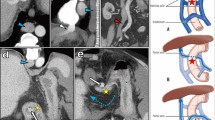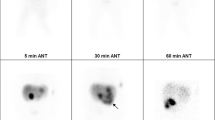Abstract
The report of a 29-year-old woman with polysplenia syndrome, Crohn's disease, and bilateral cataracts is presented. The patient was noted to have a right-sided stomach and small bowel, Crohn's ileitis, and a left-sided colon. Results of roentgenography of the chest and echocardiography were consistent with a diagnosis of hypoplasia of the inferior vena cava with azygos continuation. The patient underwent laparotomy with cholecystectomy, exploration of the common bile duct, and choledochoscopy for cholelithiasis, choledocholithiasis, and chronic cholecystitis. Laparotomy revealed a liver that had two lobes, each with the morphologic appearance of the left lobe. The gallbladder was centrally located. T-tube cholangiography revealed a quadruplication of the intrahepatic biliary ducts. To our knowledge, this patient is the only known adult with this syndrome in whom cholangiography demonstrated isomerism of the biliary tree. A review of the literature on this subject is given with emphasis on biliary anomalies.
Similar content being viewed by others
References
Vaughan TJ, Hawkins IF Jr, Elliott LP. Diagnosis of polysplenia syndrome.Radiology 1971; 101:511–518
Baillie M. An account of a remarkable transposition of the viscera.Philos Trans R Soc Lond 1788; 78:350–363
Peoples WM, Moller JH, Edwards JE. Polysplenia: a review of 146 cases.Pediatr Cardiol 1983; 4:129–137
Miyabara S, Sugihara H, Kamio A, Oota K, Abe H, Kalo S. A typical polysplenia only with absence of the hepatic segment of inferior vena cava in a middle-aged.Acta Pathol Jpn 1984; 34:111–116
Niikawa N, Kohsaka S, Mizumoto M, Hamada I, Kajii T. Familial clustering of situs inversus totalis, and asplenia and polysplenia syndromes.Am J Med Genet 1983; 16:43–47
Polhemus DW, Schafer WB. Congenital absence of the spleen: syndrome with atrioventricularis and situs inversus. Case reports and review of the literature.Pediatrics 1952; 9:696–708
Zlotogora J, Elian E. Asplenia and polysplenia syndromes with abnormalities of lateralisation in a sibship.J Med Genet 1981; 18:301–302
de la Monte SM, Hutchins GM. Sisters with polysplenia.Am J Med Genet 1985; 21:171–176
Arnold GL, Bixler D, Girod D. Probable autosomal recessive inheritance of polysplenia, situs inversus and cardiac defects in an Amish family.Am J Med Genet 1983; 16:35–42
Chandra RS. Biliary atresia and other structural anomalies in the congenital polysplenia syndrome.J Pediatr 1974; 85:649–655
Sullivan RF, Madell SJ, Oates E, Sarno RC. A case of biliary atresia and polysplenia: evaluation by hepatobiliary scintigraphy.Clin Nucl Med 1987; 12:55–56
Abramson SJ, Berdon WE, Altman RP, Amodio JB, Levy J. Biliary atresia and noncardiac polysplenic syndrome: US and surgical considerations.Radiology 1987; 163:377–379
Yamagiwa I, Ohta M, Obata K, Washio M. Case report of biliary atresia associated with preduodenal portal vein, ventricular septal defect and bilobed spleen.Z Kinderchir 1988; 43:108–109
Maksem JA. Polysplenia syndrome and splenic hypoplasia associated with extrahepatic biliary atresia.Arch Pathol Lab Med 1980; 104:212–214
Shinohara Y, Komiya S, Nakashima A, Nakashima T, Takeuchi S, Ono E, Yukizane S, Tanaka C, Matsuishi T, Koga T, Hieda Y, Nakashima H, Ichikawa A. Asplenia and polysplenia syndrome.Acta Pathol Jpn 1982; 32:505–511
Griffiths JD, Marshall VC. Torsion of the spleen in the polysplenia syndrome.Aust N Z J Surg 1984; 54:571–573
Vossen PG, Van Hedent EF, Degryse HR, De Schepper AM. Computed tomography of the polysplenia syndrome in the adult.Gastrointest Radiol 1987; 12:209–211
Fisher MR, Hricak H, Higgins CB. Magnetic resonance imaging of developmental venous anomalies.AJR 1985; 145:705–709
Hirohata S, Isobe H, Mitamura T, Yoshinoya S, Miyamoto T, Motoki T, Koide T. Situs ambiguous with polysplenia complicated by renal adenocarcinoma.Arch Intern Med 1985; 145:1134–1137
Matsusue S, Kashihara S, Koizumi S. Pancreatectomy for carcinoma of the head of the pancreas associated with multiple anomalies including the preduodenal portal vein.Jpn J Surg 1984; 14:394–398
Author information
Authors and Affiliations
Rights and permissions
About this article
Cite this article
Gagner, M., Munson, J.L. & Scholz, F.J. Hepatobiliary anomalies associated with polysplenia syndrome. Gastrointest Radiol 16, 167–171 (1991). https://doi.org/10.1007/BF01887336
Received:
Accepted:
Issue Date:
DOI: https://doi.org/10.1007/BF01887336




